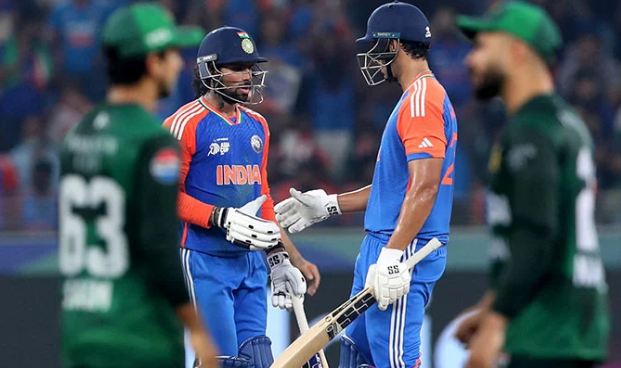Pakistan’s much-anticipated Asia Cup 2025 clash against arch-rivals India turned into yet another heartbreak for the Green Shirts. In what was expected to be a close contest, Pakistan faltered badly, managing only 146 runs in their innings, eventually conceding defeat to the tournament’s number one ranked side. While the scoreboard tells one part of the story, the underlying causes of this defeat are far more alarming, pointing to chronic mismanagement, questionable leadership, and a lack of meritocracy in team selection.
The match began with some promise as Pakistan’s openers provided a steady platform. For a brief period, there was hope that the team could post a respectable total against a formidable Indian bowling attack. However, once the opening partnership was broken, the middle order once again crumbled under pressure.
This pattern has become a recurring theme for Pakistan cricket in recent years: bright starts followed by inexplicable collapses. Against a team like India, who are known for capitalizing on opponents’ weaknesses, such a lack of resilience is unforgivable. The inability to rotate strike, poor shot selection, and a visible lack of planning doomed Pakistan’s innings, leaving the bowlers with very little to defend.
Much of the criticism following the loss has centered on newly appointed captain Salman Aga. Handed the reins of the team at a critical time, Aga’s leadership raised more questions than answers. His field placements were unimaginative, his bowling changes lacked strategy, and most concerningly, he appeared out of his depth when the game was slipping away.
It is not entirely fair to blame a young player thrust into the captaincy role prematurely. Leadership in cricket is as much about temperament as it is about talent, and Aga, though promising with the bat, is clearly not ready to shoulder such responsibility. The decision to appoint him skipper reflects poorly on the Pakistan Cricket Board’s decision-making process.
India’s dominance in world cricket is no accident. Their consistent policy of picking players purely on merit, avoiding favoritism, and sticking with a long-term vision has paid dividends. Every player in the Indian lineup is deserving of his place, having proven himself through domestic and international performances. This culture of accountability ensures that no undeserving player occupies a position in the squad.
Pakistan, by contrast, has allowed politics, nepotism, and favoritism to dictate selections. As a result, several players with questionable credentials continue to feature in the national side, while more deserving talents are ignored. It is this fundamental difference in approach that explains why India sits comfortably as the world’s top team, while Pakistan continues to struggle for consistency.
Beyond the players, the spotlight now falls on the Pakistan Cricket Board (PCB) and its leadership. Chairman Mohsin Naqvi has come under sharp criticism for his inability to run the board effectively. His tenure has been marked by ad-hoc decisions, frequent changes in management, and a tendency to surround himself with hand-picked cronies lacking experience or credibility in cricket administration.
Reports of corruption, favoritism, and lack of transparency have further eroded public trust. Many observers believe that the real problem lies not with the players but with the system that selects and manages them. Unless this culture of mismanagement is addressed, Pakistan will continue to stumble, no matter how much individual talent the country produces.
At least four players in the current squad, including captain Salman Aga, are widely considered unfit for international cricket at this level. Their continued presence in the team underscores the lack of accountability in the selection process. Names like Babar Azam and Mohammad Rizwan, once the backbone of Pakistan’s batting, are being discussed as possible reinclusions, given the team’s desperate need for experience and stability.
The absence of senior players who can anchor the innings and mentor younger talents is glaring. A balanced team requires both youth and experience, but Pakistan’s current setup seems to ignore this principle. The result is a fragile middle order, a leadership vacuum, and repeated failures on the big stage.
If Pakistan cricket is to recover from this downward spiral, it must begin with soul-searching at the highest levels. Cosmetic changes will not suffice. What is needed is a complete overhaul of team management and selection committees. Deserving players must be brought into the side, irrespective of politics or personal affiliations. The culture of nepotism and favoritism has to end if Pakistan wants to compete with the best.
Moreover, senior players must be reintegrated into the squad to provide balance and guidance. Leadership roles should be assigned based on merit and maturity, not experimentation or favoritism. Until these steps are taken, Pakistan cricket will continue to suffer humiliations like the one witnessed against India.
Ironically, Pakistan still came close to challenging the number one team in the world. With better planning and leadership, the result might have been very different. This near miss should serve as a wake-up call: talent alone is not enough. Without structure, strategy, and merit, even the most gifted players cannot deliver consistently.
India’s victory was not just a result of superior skill but of a system that rewards merit and accountability. Pakistan’s defeat, on the other hand, was a symptom of deeper structural flaws that continue to plague the national team.
Pakistan’s loss to India in the Asia Cup 2025 was not just about runs and wickets; it was about vision and management. Until the PCB reforms itself, embraces meritocracy, and puts an end to favoritism, Pakistan cricket will remain stuck in a cycle of underachievement and disappointment.
The humiliation at the hands of India should not be brushed aside as just another loss—it should be remembered as a turning point. If lessons are not learned now, then more humiliations await.

















